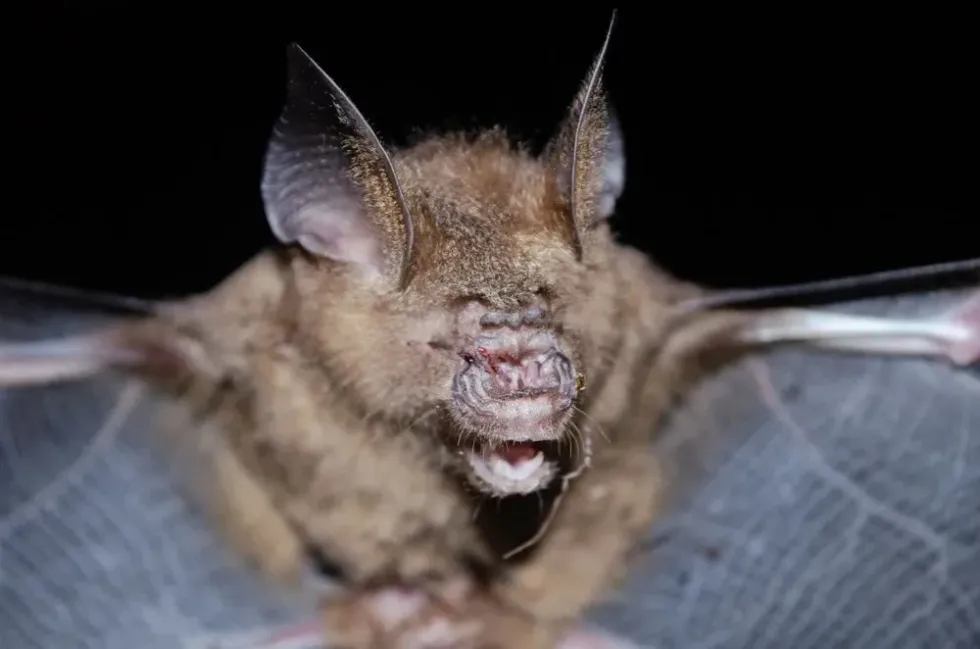Tree bats are a species of bat belonging to the family Phyllostomidae and are nocturnal mammals, being observed to fly and hunt at night. These bats are omnivorous in nature and known to feed on fruits, nectar, and a wide variety of insects.
They are known to be quite adept at hunting despite being active only at night, using echolocation in order to find and hunt down their prey. They are also quite voracious eaters, being observed to eat their weight in insects every night!
Tree bats are quite small in size, having a wingspan larger than their entire body length. They can be identified by their triangular ears as well as their distinct leaf-shaped nose, caused by an extra fold of skin.
To learn more facts about bats, read on! For more relatable content, check out these hoary bat facts and Mexican free-tailed bat facts for kids.
Tree Bat Interesting Facts
What type of animal is a tree bat?
The tree bat is a type of bat belonging to the New World leaf-nosed bat family Phyllostomidae.
What class of animal does the tree bat belong to?
The tree bat belongs to the class of Mammalia.
How many tree bats are there in the world?
The exact number of these bats in the wild is currently unknown. However, their current IUCN Red List status is of Least Concern, meaning they are very common in the wild and are not endangered.
Where does the tree bat live?
The tree bat is a species of bats that can be found in a wide variety of habitats, including tropical and subtropical forests, deserts in the U.S, South America, Dominica, Guadeloupe, Martinique, Montserrat, Netherlands Antilles, Saint Lucia, Saba, and Saint Vincent and the Grenadines.
Many times, one can stumble upon a group or colony of bats hanging upside down in caves.
What is a tree bat's habitat?
Tree bats can be found inhabiting a wide range of natural habitats, ranging from all types of forests such as tropical and subtropical forests, deciduous forests, rainforests, and arid areas such as sandbanks, deserts, and caves. They prefer living in areas in warm temperatures.
Who does the tree bat live with?
Tree bats live and roost in small groups which feed and sleep together, known as a colony. Some bats like eastern red bats roost individually, hanging from a single foot. They roost either in trees or caves, hanging upside down and emerging at night.
How long does a tree bat live?
Tree bats are known to live for between 20-30 years on average, which is a quite long lifespan!
How do they reproduce?
All species of bats are mammals and reproduce sexually, giving live birth to their pups. They undertake a mating flight which takes place mid-air, its mating site actually being on the ground.
Young tree bats reach reproductive maturity at the age of two years, with mating usually taking place in the winter months. After the pup develops in its mother's womb for about eight to nine months, it is born fully furred and with open eyes and ears.
What is their conservation status?
The conservation status of this flying mammal is currently of Least Concern, as they are quite common in the wild, can be found in a variety of natural habitats, and are not endangered.
Tree Bat Fun Facts
What does a tree bat look like?
 *We've been unable to source an image of a tree bat and have used an image of a brown bat instead. If you are able to provide us with a royalty-free image of a tree bat, we would be happy to credit you. Please contact us at hello@kidadl.com.
*We've been unable to source an image of a tree bat and have used an image of a brown bat instead. If you are able to provide us with a royalty-free image of a tree bat, we would be happy to credit you. Please contact us at hello@kidadl.com.The leaf-nosed tree bat is black, brown, or gray in color, with triangular ears and a flat, leaf-shaped nose. It has an extra growth of skin on its nose, giving it its distinctive leaf shape. Like all other leaf-nosed bats, it lacks a tail and has wings with a leathery membrane that is void of fur.
How cute are they?
These small, long-eared bats can be very cute. Despite being viewed as scary pests by most, they are very cute if seen up close with their large triangular ears and round black eyes. With their furry bodies, they can look quite cuddly.
How do they communicate?
Insect-seeking bats use echolocation in order to communicate, the sound waves being too high for human ears to detect. As they hunt at night when visibility is low, they give off shrill screeches that come into contact with prey, the sounds bouncing back towards them which help bats to determine the prey's location.
During the mating season, male bats give off chemical scents called pheromones which are reciprocated by the females.
How big is the tree bat?
Though the exact tree bat size is unknown, it is believed to be in the range of 2.4-2.9 in (60-73 mm). It belongs to the New World leaf-nosed bat family, which has a size range of 1.6-5.3 in (4-13.5 cm). These bats have a wingspan of around 35.4 in (90 cm).
How fast can a tree bat move?
The speed at which most bats fly is recorded to be around 10 mph (16 kph).
How much does a tree bat weigh?
Though the exact weight of the tree bat is unknown, it weighs between 0.5-0.7 oz (15.1-18.7 g). They belong to the New World leaf-nosed bats that weigh between a range of 0.2-2.3 oz (6.4-65 g). The world's smallest bat is the bumblebee bat of Thailand, which weighs less than a penny!
What are the male and female names of the species?
There are no separate names for either sex of this species, simply being called male and female tree bats.
What would you call a baby tree bat?
Baby tree bats are called pups.
What do they eat?
Tree bats are mostly omnivorous in nature, with their eating habits being nocturnal. They use echolocation to hunt, picking up on sounds to find their prey. Spending most of their time in trees, they feed on a variety of fruits and occasionally on nectar.
They also feed on a wide range of insects such as grasshoppers, crickets, moths, flies, and beetles. The types of insects differ from location to location. Bats have been observed to eat between 1,200-6,000 insects per hour!
Are they dangerous?
No, this bat species is not dangerous unless they bite. They will not directly attack humans, often swooping close to catch any prey lurking nearby, but will not bite unless they feel threatened or are provoked. However, their bite can transmit rabies, a deadly disease that can prove fatal if not caught and treated in time.
Would they make a good pet?
No, tree bats can carry a variety of diseases such as rabies which can prove deadly if transmitted. Being wild animals, they may not be able to get used to confinement or captive life and may never be tamed.
They might scratch, bite or attack if provoked which poses a huge risk to owners. It is not worth trying to domesticate these mammals, and they are better left alone in the wild.
Did you know...
According to bat facts, bats are nocturnal, meaning they roost during the day and are active at night. They use echolocation to locate their prey in the dark.
The eastern red bat is a species of tree bat that resembles dead leaves while it is roosting, making it very hard to spot!
Some bat species are migratory, knowing to head towards places with warmer temperatures in order to avoid the winter cold.
Tree bats are known to hibernate in the winter. They usually hibernate in caves or inside of tree trunks.
Vespertilionidae, Molossidae, Mormoopidae, and Phyllostomidae are North American bat families. The bats in the U.S are affected by a fatal disease called the white-nose syndrome. This infection affects the animal's fat reserves, preventing the bat from surviving its winter hibernation, and there is no cure developed for the white-nose syndrome yet.
Leaf-nosed bats perform mating rituals mid-air while flying before they head towards the ground to mate.
Bats often eat their weight in insects every night, with some bat species being observed to eat 6,000 insects an hour!
Unlike bird wings, a bat-wing is more like a hand or like feet, the leathery wing membrane ending in distinct fingers. Their wings can also be used to detect sonar rays, helping them to detect prey.
Bats are known to groom each other, the cleaning activity helping to control the emergence of various skin parasites and lice.
The largest bat in the world is called flying foxes, which can be found on islands in the South Pacific. Flying foxes have a wingspan of around 6 ft (1.8 m).
Bats can be kept away from fruit trees or orchards with the use of thick nets. Hanging shiny objects in trees also discourages them from coming close, as well as using mothballs, which repels bats.
Do tree bats feed on blood?
No, tree bats do not feed on blood. The only mammal which sustains itself entirely on blood is the vampire bat, which belongs to the same family as the tree bat. The tree bat is omnivorous in nature, eating insects, leaves, fruit, and nectar.
Are the tree bats dangerous?
No, tree bats will not bite unless provoked. Though like most other bats, they may harbor rabies, a disease that can prove to be fatal if it infects the human body.
Outside of that, these bats are quite harmless and will keep to themselves. Bats may sometimes fly close to humans while hunting, though it is nothing to worry about.
Here at Kidadl, we have carefully created lots of interesting family-friendly animal facts for everyone to discover! Learn more about some other mammals from our red bat interesting facts and fruit bat surprising facts pages.
You can even occupy yourself at home by coloring in one of our free printable tree bat coloring pages.
*We've been unable to source an image of a tree bat and have used an image of an intermediate leaf-nosed bat instead. If you are able to provide us with a royalty-free image of a tree bat, we would be happy to credit you. Please contact us at hello@kidadl.com.




 *We've been unable to source an image of a tree bat and have used an image of a brown bat instead. If you are able to provide us with a royalty-free image of a tree bat, we would be happy to credit you. Please contact us at hello@kidadl.com.
*We've been unable to source an image of a tree bat and have used an image of a brown bat instead. If you are able to provide us with a royalty-free image of a tree bat, we would be happy to credit you. Please contact us at hello@kidadl.com.



